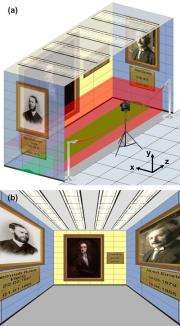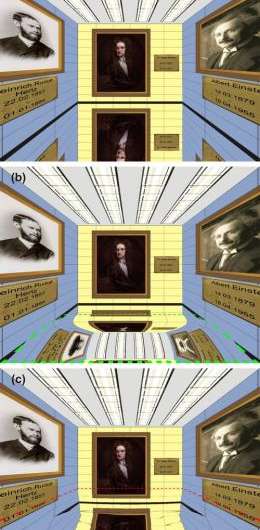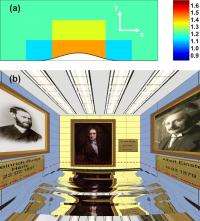Invisibility visualized: German team unveils new software for rendering cloaked objects

(PhysOrg.com) -- Scientists and curiosity seekers who want to know what a partially or completely cloaked object would look like in real life can now get their wish -- virtually. A team of researchers at the Karlsruhe Institute of Technology in Germany has created a new visualization tool that can render a room containing such an object, showing the visual effects of such a cloaking mechanism and its imperfections.
To illustrate their new tool, the researchers have published an article in the latest issue of Optics Express, the Optical Society's (OSA) open-access journal, with a series of full-color images.
These images show a museum nave with a large bump in the reflecting floor covered by an invisibility device known as the carpet cloak. They reveal that even as an invisibility cloak hides the effect of the bump, the cloak itself is apparent due to surface reflections and imperfections. The researchers call this the "ostrich effect" -- in reference to the bird's mythic penchant for partial invisibility.
"It's important to visualize how an optical device works," explains Jad C. Halimeh, a Master of Science graduate of the Karlsruhe Institute of Technology in Germany who wrote and tested the new software as part of his Master's thesis.
The software, which is not yet commercially available, is a visualization tool designed specifically to handle complex media, such as metamaterial optical cloaks. Metamaterials are man-made structured composite materials that exhibit optical properties not found in nature. By tailoring these optical properties, these media can guide light so that cloaking and other optical effects can be achieved.

In 2006, scientists at Duke University demonstrated in the laboratory that an object made of metamaterials can be partially invisible to particular wavelengths of light (not visible light, but rather microwaves). A few groups, including one at the University of California, Berkeley, have achieved a microscopically-sized carpet cloak. These and other studies have suggested that the Hollywood fantasy of invisibility may one day be reality.
While such invisibility has been achieved so far in the laboratory, it is very limited. It works, but only for a narrow band of light wavelengths. Nobody has ever made an object invisible to the broad range of wavelengths our eyes can see, and doing so remains a challenge.
Another challenge has been visualizing a cloaked object. It is very likely that any invisibility cloak would remain partly seen because of imperfections and optical effects. Up to now, nobody has been able to show what this would look like -- even on a computer.
The problem is that metamaterials may have optical properties that vary over their length. Rendering a room with such an object in it requires building hundreds of thousands of distinct volume elements that each independently interact with the light in the room. The standard software that scientists and engineers use to simulate light in a room only allows for a few hundred volume elements, which is nowhere close to the complexity needed to handle many metamaterials such as the carpet cloak, says Halimeh.
So he and his colleagues built the software needed to do just that. Wanting to demonstrate it, they rendered a virtual museum niche with three walls, a ceiling, and a floor. In the middle of the room, they place the carpet cloak - leading the observer to perceive a flat reflecting floor, thus cloaking the bump and any object hidden underneath it.

More information: Paper: "Photorealistic images of carpet cloaks," Jad C. Halimeh et al, Optics Express, Vol. 17, Issue 22, October 26, 2009, pp. 19328, abstract at www.opticsinfobase.org/oe/abst … m?uri=oe-17-22-19328 .
Source: Optical Society of America (news : web)
















